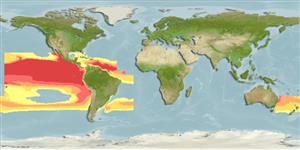>
Aulopiformes (Grinners) >
Scopelarchidae (Pearleyes)
Etymology: Scopelarchoides: Greek, skopelos = a lantern fish + Greek, archos = anus + Greek, oides = similar (Ref. 45335).
Environment: milieu / climate zone / depth range / distribution range
Écologie
marin bathypélagique; profondeur 1 - 3294 m (Ref. 26340). Deep-water; 27°N -
Western Central Atlantic: Cuba (Ref. 26340). Eastern Pacific: Baja California, Mexico (about 27°N) to equatorial waters off Panama and Colombia (5°-9°N), and off Peru (about 6°-12°S) (Ref. 35929); also Chile (Ref. 9068).
Taille / Poids / Âge
Maturity: Lm ? range ? - ? cm
Max length : 10.5 cm SL mâle / non sexé; (Ref. 130965)
Épines dorsales (Total) : 0; Rayons mous dorsaux (Total) : 6 - 7; Épines anales: 0; Rayons mous anaux: 20 - 23; Vertèbres: 45 - 48. Branchiostegal rays: 8.
Occur in shallower part of depth range at night, deeper during the day (Ref. 35929). Oviparous, with planktonic larvae (Ref. 35929). Synchronous hermaphrodites (Ref. 35929).
Life cycle and mating behavior
Maturities | Reproduction | Spawnings | Egg(s) | Fecundities | Larves
Claro, R., 1994. Características generales de la ictiofauna. p. 55-70. In R. Claro (ed.) Ecología de los peces marinos de Cuba. Instituto de Oceanología Academia de Ciencias de Cuba and Centro de Investigaciones de Quintana Roo. (Ref. 26340)
Statut dans la liste rouge de l'IUCN (Ref. 130435)
Menace pour l'homme
Harmless
Utilisations par l'homme
Outils
Articles particuliers
Télécharger en XML
Sources Internet
Estimates based on models
Preferred temperature (Ref.
123201): 3.5 - 9.5, mean 5.2 °C (based on 238 cells).
Phylogenetic diversity index (Ref.
82804): PD
50 = 0.5313 [Uniqueness, from 0.5 = low to 2.0 = high].
Bayesian length-weight: a=0.01122 (0.00514 - 0.02450), b=3.04 (2.87 - 3.21), in cm total length, based on all LWR estimates for this body shape (Ref.
93245).
Niveau trophique (Ref.
69278): 4.1 ±0.7 se; based on size and trophs of closest relatives
Fishing Vulnerability (Ref.
59153): Low vulnerability (10 of 100).
